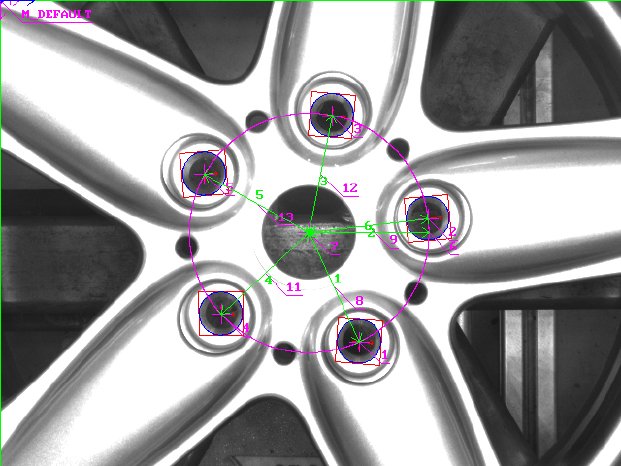Two six-axis Kuka industrial robots - one located on each side of a car body - gather wheel bolts and rims from their supply stations and screw them onto the car. The robots are synchronized with the conveyor and follow the car’s movement during assembly. Attached to each robot is a Matrox Iris GT smart camera, which locates the rim’s center point and calculates its position (x, y), rotation (Rz) of the bolt circle, and distance to the camera (z) in calibrated coordinates. Before these coordinates are given to the robot, the smart camera checks to see if the recognized rim design matches the rim that is expected to be given by the PLC. This last test prevents the wrong rim design from being mounted on the vehicle. 13 different wheel combinations — seven rim designs and four types of lacquer (white, silver, anthracite, black) — are identified. The entire automated wheel assembly process has a cycle time of only one minute. Also attached to each robot is specialized lighting with polarized and infrared filters.
Smart camera-based image processing
The image processing system is based upon the Matrox Iris GT smart camera. The application was developed with Matrox Design Assistant, an integrated development environment (IDE) that is bundled with the camera. The IDE lets users create machine vision applications by constructing a flowchart instead of coding programs or scripts using languages like Visual Basic. Once development is finished, the project (or flowchart) is uploaded and stored locally on the Matrox Iris GT. The project is then executed on the smart camera and monitored from the web-based HMI running on a PC.
A number of Design Assistant tools or flowchart steps are used. Image acquisition and processing are triggered by a command from the network link, which contains information about the measurement job and the expected rim type. Several model finder steps are used to locate the wheel’s bolt circle and to verify the expected type of design. The metrology step then calculates the rim’s position and orientation based on data provided by the model finder occurrences. TCP/IP-Connection ensures communication between the smart cameras and the PLC. Results and images are logged on a shared network folder - using text writer and image writer steps - and can be downloaded by remote maintenance for fault analysis.
Some challenges
IBG is a long-standing customer of Matrox smart camera technology. Kai Kluwe, Head of Software Development Machine Vision / Measurement at IBG, explains, “Our experience with Matrox Iris smart cameras and its software has been very positive - we’ve deployed successful projects in the past using Design Assistant’s efficient edge-based search tools”. IBG is also extremely pleased with the level of technical support that was offered to them. In addition to the skilled local assistance that they received from Rauscher GmbH, Matrox Imaging’s master distributor in Germany, IBG took advantage of expertise available from Matrox Imaging’s Montreal-based, Vision Squad, a team of algorithm gurus who help customers assess application feasibility and determine how to best use Matrox software to solve application challenges. In this case, these challenges included IBG’s need to handle different design and color combinations along with overlapping rims - resulting from their placement on the skid. The latter required a clever algorithm based on the Geometric Model Finder and Metrology steps to only use the indicative features belonging to the rim in the foreground while discarding those that belong to rims behind it. Other challenges included having different settings for image acquisition and Model Finder steps on each side of the assembly line and for each rim type, and ensuring reliable depth measurement with a 2D camera. “The Vision Squad provided an alternate and optimized method of using the Metrology tool so that we were able to improve overall robustness“, explains Kluwe.
Deployment
In summer 2009, the assembly system deployed for the first time - mounting wheels on BMW X3s. The assembly line was then modified in summer 2010 to accommodate the new Mini Countryman’s different rim designs. This modification required extensive customization in the Design Assistant project. In March 2011, IBG collaborated with Rauscher GmbH and Matrox Imaging’s Vision Squad to rework the locating algorithm, which resulted in significant improvements in cycle time. Throughout the entire process, IBG has taken advantage of the enhanced features and functionality offered in the newer version of Design Assistant software.
Currently this Matrox Iris smart camera-based inspection system is used on one production line at Magna Steyr (Graz, Austria) to automatically mount wheels onto continuously moving vehicle bodies. And at Volkswagen (Emden, Germany), two more production lines use the system in wheel supply stations to detect the rotation of the wheel’s bolt circle.
In autumn 2010, the Federation of German Chambers of Industry and Commerce presented IBG with the Potenzial Innovation award for innovative developments. And at the 2011 Hannover Messe, IBG won the Robotics Award for the application “Automated assembly of a frontend module on the fly”.
Link Matrox Iris GT Design Assistant
www.rauscher.de/...
RAUSCHER
Johann-G.Gutenberg-Str. 20
D-82140 Olching
Phone +49 81 42 / 4 48 41-0
Fax +49 81 42 / 4 48 41-90
E-Mail: info@rauscher.de
www.rauscher.de


